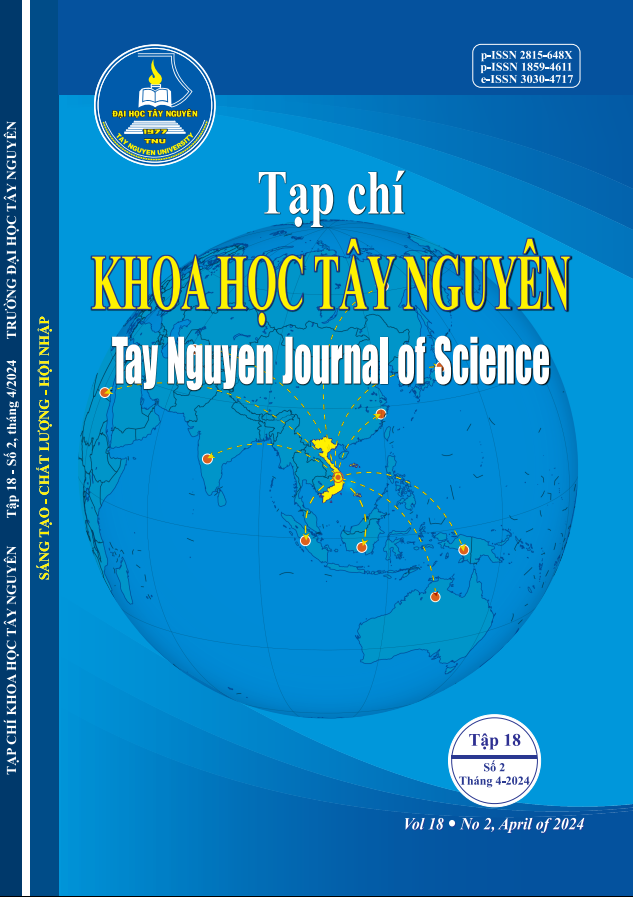Khảo sát ảnh hưởng của các chất điều hòa sinh trưởng lên sự tạo chồi và tạo rễ cây tre Tứ Quý (Bambuseae sp.) trong điều kiện in vitro
Main Article Content
Khảo sát ảnh hưởng của các chất điều hòa sinh trưởng lên sự tạo chồi và tạo rễ cây tre Tứ Quý (Bambuseae sp.) trong điều kiện in vitro
Tóm tắt
Nghiên cứu được tiến hành nhằm mục đích khảo sát ảnh hưởng của hai nhóm chất điều hòa sinh trưởng thực vật cytokinin (BA và Kinetin) và auxin (NAA) lên khả năng tạo chồi và tạo rễ ở cây tre Tứ Quý in vitro. Kết quả nghiên cứu cho thấy, khả năng tạo chồi từ các mẫu cấy trên môi trường MS (Murashige và Skoog, 1962) có chứa BA riêng lẻ hoặc kết hợp 1mg/L NAA với Kinetin ở các nồng độ khác nhau không đạt hiệu quả cao, chồi được hình thành ở tất cả các nghiệm thức, trong đó môi trường MS chứa 1 mg/L BA hoặc kết hợp giữa NAA và 1mg/L Kinetin cho hiệu quả tạo chồi tốt hơn các nghiệm thức còn lại, tuy nhiên số lượng chồi rất ít, chỉ đạt khoảng 2 chồi/mẫu. Bên cạnh đó, sự ra rễ in vitro ở chồi cũng được thực hiện trên môi trường MS chứa NAA ở các nồng độ khác nhau, kết quả cho thấy sự hình thành rễ không xảy ra ở tất cả các nghiệm thức, 100% chồi hóa nâu và chết sau 10 ngày nuôi cấy. Những kết quả trên đưa đến kiến nghị tiếp tục khảo sát các loại phytohormone khác để xác định được môi trường tối ưu cho sự tăng sinh chồi và cảm ứng ra rễ ở cây tre Tứ Quý trong điều kiện in vitro.
Article Details

Tác phẩm này được cấp phép theo Giấy phép quốc tế Creative Commons Attribution-NonCommercial-NoDeri Phái sinh 4.0 .
Tài liệu tham khảo
- Lê Văn Hòa, Nguyễn Văn Ây và Phan Thị Ánh Nguyệt. (2012). Sự tạo phôi soma và tái sinh chồi tre rồng (Dendrocalamus giganteus Wall. Ex Munro) từ nuôi cấy lớp mỏng tế bào. Tạp chí Khoa học 2012:21b 68-77. Trường Đại học Cần Thơ.
- Arya S., Sharma S. (1999). Micropropagation technology of Bambusa bambos through shoot proliferation. Indian For. 124, 725-731.
- Arya I.D. et al. (2002). Rapid and mass multiplication of bamboos through tissue culture techniques. In: S.K. Nandi, L.M.S. Palni, A. Kumar (eds). role of plant tissue culture in biodiversity conservation and economic development, Gyanodaya Prakashan, Nainital, India, pp 29-39.
- Arya I.D and Arya S. (2015). In vitro shoot Proliferation and Somatic Embryogenesis: Means of Rapid Bamboo multiplication. 10th World Bamboo Congress, Korea.
- Brar, J. (2014). Micropropagation of some edible bamboo species and molecular characterization of the regenerated plants. Ph. D thesis. Thapar University, Patiala.
- Gantait S., Pramanik B.R., Banerjee M. (2018). Optimization of planting materials for large scale plantation of Bambusa balcooa Roxb.: Influence of propagation methods. Journal of the Saudi Society of Agricultural Sciences, 17, 79–87.
- Goncalves D.S. et al. (2023). In vitro cloning of Bambusa vulgaris Schrad. ex J. C. Wendl.: Effect of culture systems, sucrose and activated charcoal supplementation. Advances in Bamboo Science, 3, 100024.
- Islam S., Rahman M.M. (2005). Micro-cloning in commercially important six bamboo species for mass propagation and at a large scale. Plant Tiss. Cult. Biotech, 15, 103-111.
- Lin C.S. et al. (2006). Albino inflorescence proliferation of Dendrocalamus latiflorus. In Vitro Cell Dev. Biol.- Plant, 42, 331-335.
- Malini and Anandakumar. (2013). Micropropagation of bamboo (Bambusa vulgaris) through nodal segment. International Journal of Forestry and Crop Improvement, 4(1), 36-39.
- Mehta, R. et al. (2010). Induction of somatic embryogenesis and analysis of genetic fidelity of in vitro derived plantlets of Bambusa nutans Wall., using AFLP markers. European Journal of Forest Research, 130(5), 729-736.
- Mudoi K.D., Saikia S.P. and Borthakur M. (2014). Effect of nodal positions, seasonal variations, shoot clump and growth regulators on micropropagation of commercially important bamboo, Bambusa nutans Wall. ex. Munro. African Journal of Biotechnology, 13(19), 1961-1972.
- Nadha, H.K. (2012). In vitro clonal propagation of some important woody bamboos and ascertaining their clonal fidelity. Ph.D. thesis. Thapar University, Patiala.
- Negi D and Saxena S. (2011). Micropropagation of Bambusa balcooa Roxb. through axillary shoot proliferation. In vitro Cellular & Developmental Biology - Plant, 47, 604–610.
- Ogita S., Harutsugu Kashiwagi, Yasuo Kato. (2008). In vitro node culture of seedlings in bamboo plant, Phyllostachys meyeri McClure. Plant Biotechnology, 25, 381–385.
- Ornellas T.S. et al. (2019). Micropropagation of Guadua chacoensis (Rojas) Londoño & P. M. Peterson. Pesq. Agropec. Trop., Goiânia, v.49, e55450.
- Ramanayake SMSD. (2006). Micropropagation of tropical bamboos. Floriculture, Ornamental and Plant Biotechnology: Advances and Topical Issues Vol 2 Global Science Books, Isleworth, UK, 540–550.
- Rout GR and Das P. (1994). Somatic embryogenesis and in vitro flowering of 3 species of bamboo. Plant Cell Rep. 13, 683-686.
- Saini H. et al. (2016). In vitro micropropagation of Himalayan weeping bamboo, Drepanostachyum falcatum. American Journal of Plant Sciences, 7, 1317-1324.
- Saxena S. (1990). In vitro propagation of the bamboo (Bambusa tulda Roxb.) through shoot proliferation. Plant Cell Rep, 9, 431-434.
- Thounaojam P., C. Nirmala, M.S. Bisht. (2018). In vitro propagation of an edible bamboo Dendrocalamus Latiflorus Munro using nodal explants. Conference: 11th World Bamboo Congress at Xalapa, Mexico.
- Yasodha R. et al. (1997). Genetic enhancement and mass production of quality propagules of Bambusa nutans and Dendrocalamus membranaceus. Indian For, 123, 303- 306.



